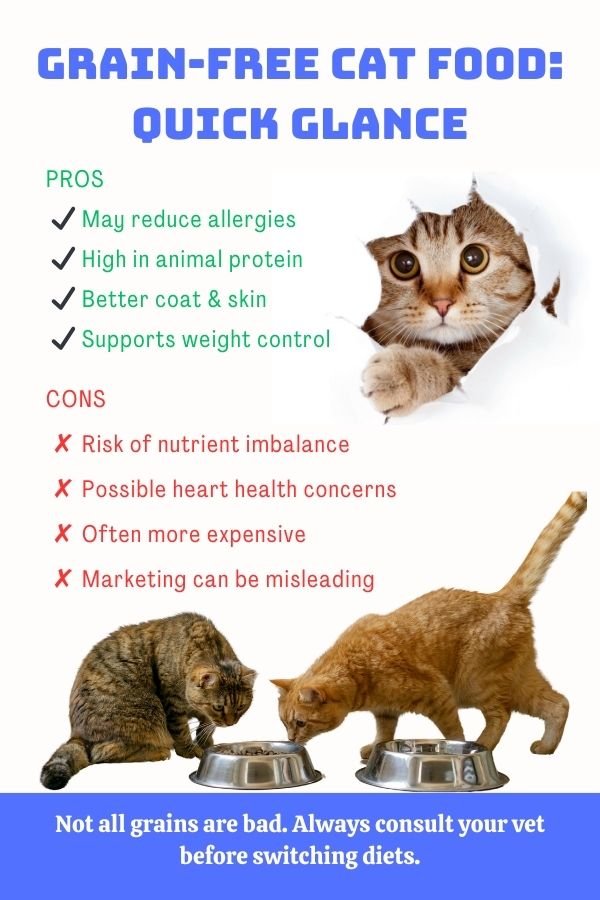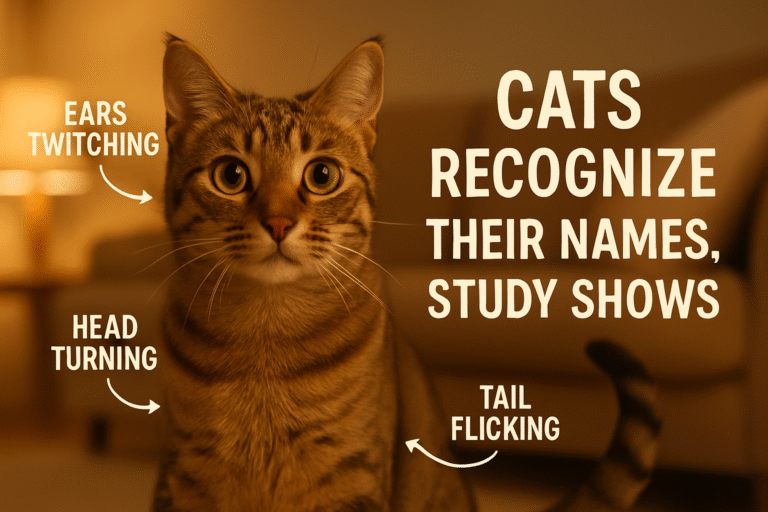Discover the pros and cons of grain-free diets for cats. Explore expert insights into cat nutrition, feline diet trends, and pet food choices.
Table of Contents
ToggleThe Pros and Cons of Grain-Free Diets for Cats
The debate surrounding grain-free diets for cats continues to gain traction among pet owners, veterinarians, and pet food manufacturers. These diets, often perceived as more natural or health-enhancing, have been promoted as ideal for feline wellness. However, not all professionals agree. In fact, various misconceptions and marketing trends have shaped how grain-free foods are perceived. Therefore, understanding the science behind cat nutrition, evaluating the ingredients, and exploring the real impact of removing grains is essential before making any decisions.
What Is a Grain-Free Diet for Cats?
Grain-free diets eliminate ingredients such as corn, wheat, rice, barley, and oats from cat food. In place of these carbohydrates, alternative ingredients like peas, lentils, chickpeas, potatoes, or tapioca are introduced.
Many believe that grain-free automatically means high protein and better quality, but that is not always the case. A product labeled grain-free may still contain high levels of carbohydrates—just from different sources. To properly assess feline diet trends, one must look beyond packaging and analyze the complete nutritional profile.
Understanding Cat Nutrition: The Obligate Carnivore
To fairly weigh the pros and cons of grain-free diets for cats, a deeper look into cat nutrition is essential. Cats are obligate carnivores, meaning their biological makeup requires animal-based proteins and specific nutrients such as:
- Taurine
- Arachidonic acid
- Vitamin A (preformed)
- Niacin
Unlike omnivores, cats have limited ability to digest plant matter efficiently. Therefore, their feline diet must rely heavily on meat. This fact fuels the belief that grains are unnecessary and even harmful. While this argument holds merit, the situation is not so black and white.

Pros of Grain-Free Diets for Cats
1. Reduced Risk of Food Allergies
Although grain allergies in cats are relatively rare, some owners report improvements in skin health or digestion after switching to grain-free options. The absence of wheat or corn may benefit cats with specific sensitivities.
2. Higher Protein Content
Many grain-free products replace carbohydrates with higher protein levels. As obligate carnivores, cats thrive on animal-based proteins. Increased protein content aligns more closely with what a cat might consume in the wild.
3. Improved Coat and Skin Health
Some owners have reported shinier coats and fewer skin irritations after switching to grain-free formulas. While this could also be attributed to other nutritional changes, it often remains one of the perceived benefits of avoiding grains.
4. Supports Weight Management
Certain grain-free formulas offer higher-quality ingredients and fewer fillers. As a result, cats may stay fuller longer, which can help prevent overeating. This outcome may benefit cats needing weight management support.
Cons of Grain-Free Diets for Cats
1. Increased Risk of Nutritional Imbalance
While marketing may present grain-free foods as healthier, they are not always better balanced. Many such diets rely heavily on plant-based carbohydrates like peas and potatoes. These can elevate the glycemic index and may not suit a biologically appropriate feline diet.
2. Potential Link to Heart Disease
The U.S. Food and Drug Administration (FDA) has investigated a possible connection between grain-free diets and dilated cardiomyopathy (DCM) in cats and dogs. Although more research is needed, early findings suggest that the overuse of legumes may interfere with nutrient absorption—specifically taurine, which is crucial for heart health.
3. Higher Cost Without Proven Benefit
Grain-free foods are often priced significantly higher than standard pet food options. However, there is little conclusive evidence proving that grain-free formulas are more beneficial for the average cat. Without a specific allergy or sensitivity, the added expense may not offer proportional value.
4. Misleading Marketing
Pet food marketing frequently leverages terms like “natural,” “grain-free,” or “ancestral.” These terms can imply superior quality without scientific backing. In many cases, a grain-free label becomes more about marketing than actual cat nutrition.
Grain Allergies in Cats: Fact vs. Fiction
Much of the popularity of grain-free diets for cats is rooted in the idea of avoiding allergens. However, scientific studies have shown that most food allergies in cats stem from animal proteins, not grains.
Common culprits include:
- Beef
- Dairy
- Fish
Therefore, switching to a grain-free formula may not resolve allergy symptoms. Identifying food sensitivities often requires an elimination diet under veterinary supervision.
The Role of Carbohydrates in a Feline Diet
Contrary to popular belief, not all carbohydrates are harmful to cats. While excessive carbs are not ideal, small amounts can serve as a digestible energy source.
In balanced pet food, complex carbohydrates can aid in digestion and stool quality. It should be noted that whole grains like brown rice or oats may contribute fiber, vitamins, and antioxidants.
Thus, not all grains should be dismissed as filler. The nutritional profile and ingredient quality matter far more than the simple presence or absence of grains.
What to Look for in Grain-Free Cat Food
When choosing a grain-free option, consider the following:
- Protein source: Is it high-quality and animal-based?
- Carbohydrate content: Are alternative carbs like peas and potatoes used in moderation?
- Taurine levels: Is taurine adequately supplemented?
- AAFCO compliance: Does the food meet standards set by the Association of American Feed Control Officials?
Examining the full ingredient list and nutritional panel remains more important than any label claim.
The Importance of Veterinary Consultation
Before making changes to a cat’s diet—especially something as significant as eliminating grains—a veterinarian should be consulted. Cats have unique nutritional needs, and not all pets respond the same to dietary changes.
Veterinarians can:
- Rule out allergies or health issues
- Suggest brands that meet quality standards
- Recommend tailored diets based on your cat’s age, breed, or condition
Professional input ensures that changes support overall cat nutrition and long-term wellness.
Homemade Grain-Free Diets: Risks and Considerations
Some pet owners prefer homemade diets for greater control over ingredients. While this method offers customization, it also introduces the risk of nutritional deficiency.
Common pitfalls include:
- Inadequate taurine levels
- Imbalanced calcium-to-phosphorus ratios
- Missing essential vitamins
If a homemade grain-free feline diet is pursued, a veterinary nutritionist must be involved to develop a complete and balanced recipe.
Grain-Free Diets for Kittens and Senior Cats
Nutritional needs vary with age. Kittens require diets rich in calories, protein, and essential nutrients to support growth. Not all grain-free formulas meet these demands.
On the other hand, senior cats may require diets lower in calories and higher in joint-supporting nutrients. The carbohydrate and protein balance in grain-free foods may not always be suitable for these life stages.
Careful evaluation of the specific product and age-appropriateness is crucial.
How to Identify High-Quality Pet Food—Grain-Free or Not
Regardless of whether you choose a grain-free or grain-inclusive product, the quality of pet food should be assessed based on:
- Named protein sources (e.g., “chicken” vs. “meat by-products”)
- Minimal fillers and artificial additives
- Transparent sourcing and labeling
- Positive brand reputation and recalls history
Grain-free does not guarantee quality. A well-balanced grain-inclusive food may outperform a poorly formulated grain-free option.
Conclusion: Is a Grain-Free Diet Right for Your Cat?
There is no universal answer. While grain-free diets for cats may benefit some pets—especially those with confirmed grain sensitivities—such diets are not automatically superior. When viewed through the lens of cat nutrition, feline diet requirements, and scientific evidence, it becomes clear that:
- High protein from animal sources is critical
- Balanced nutrients matter more than grain elimination
- Veterinary advice is essential before switching
- Marketing should not replace nutritional fact
Informed decisions lead to healthier cats. Whether grain-free or not, the goal remains the same: providing a diet that supports long-term wellness, meets all nutritional needs, and aligns with your cat’s individual health profile.
Recent Posts









Related Topics
Copyright © 2025 The Pet Blog – Expert Tips, Care Guides & Fun Facts for Every Pet Lover.

